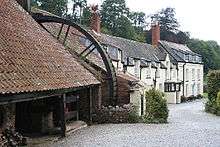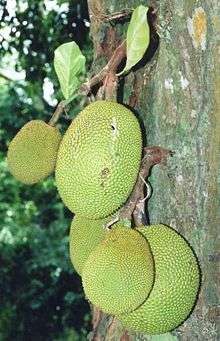Tanbark

Tanbark is the bark of certain species of tree. It is traditionally used for tanning hides into leather.[1]
The words "tannin", "tanning", "tan," and "tawny" are derived from the Medieval Latin tannare, "to convert into leather."
Bark mills are horse- or oxen-driven or water powered edge mills[2] and were used in earlier times to shred the tanbark to derive tannins for the leather industry. A "barker" was a person who stripped bark from trees to supply bark mills.
Tanbark around the world

In Europe, oak is a common source of tanbark. Quercitannic acid is the chief constituent found in oak barks.[3] The bark is taken from young branches and twigs in oak coppices and can be up to 4 mm thick; it is grayish-brown on the outside and brownish-red on the inner surface.[4]
In some areas of the United States, such as northern California, tanbark is often called "mulch," even by manufacturers and distributors. In these areas, the word "mulch" may refer to peat moss or to very fine tanbark. In California, Lithocarpus densiflorus (commonly known as the tanoak or tanbark-oak) was used. In America, condensed tannins are also present in the bark of blackjack oak (Quercus marilandica).[5] In New York, on the slopes of Mount Tremper, hemlock bark was a major source of tanbark during the 19th century.
Around the Mediterranean Sea, sumach (Rhus coriaria) leaves and bark are used.
In Africa and Australia, acacia (called "wattle") bark is used by tanners.
 Tool to recover bark from oak branches
Tool to recover bark from oak branches Recovery of bark from oak branches
Recovery of bark from oak branches Another view of the process
Another view of the process The bark of an oak tree
The bark of an oak tree Young red oak bark
Young red oak bark
See also
References
- ↑ Chapter 8 - Tannins: Major Sources, Properties and Applications. Antonio Pizzi, Monomers, Polymers and Composites from Renewable Resources 2008, Pages 179-199, doi:10.1016/B978-0-08-045316-3.00008-9
- ↑ cslib.cdmhost.com
- ↑ Quercus on www.henriettesherbal.com
- ↑ Oak on www.online-health-care.com
- ↑ Flavan and procyanidin glycosides from the bark of blackjack oak. Young-soo Bae, Johann F.W. Burger, Jan P. Steynberg, Daneel Ferreira and Richard W. Hemingway, Phytochemistry, Volume 35, Issue 2, January 1994, Pages 473-478, doi:10.1016/S0031-9422(00)94785-X
External links
| Wikimedia Commons has media related to Tanbark. |
